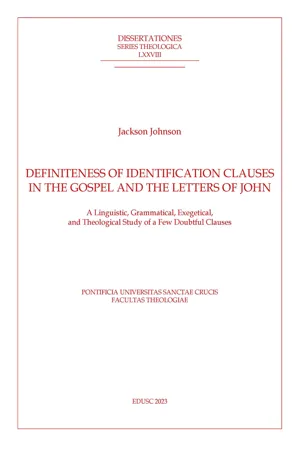
Definiteness of Identification Clauses in the Gospel and Letters of John
A Linguistic, Grammatical, Exegetical, and Theological Study of a Few Doubtful Clauses
- 323 pages
- English
- ePUB (mobile friendly)
- Available on iOS & Android
Definiteness of Identification Clauses in the Gospel and Letters of John
A Linguistic, Grammatical, Exegetical, and Theological Study of a Few Doubtful Clauses
About this book
This dissertation explores identification clauses in the Gospel and Letters of John, focusing on four major elements: linguistic, grammatical, exegetical, and theological. With at least 386 identification clauses in the New Testament (NT), 135 are found in the Gospel and Letters of John (34.97%). The research incorporates insights from general linguistics into Greek grammar, particularly in the study and interpretation of identification clauses.The first chapter introduces the concept of definiteness, definite and indefinite articles, and four theories of definiteness in general linguistics. The second chapter focuses on the concept of definiteness and identification clauses in Greek grammars. The third chapter analyses the traditional and linguistic concepts of the word order of Greek clauses in the NT, focusing on markedness and prominence. The fourth chapter provides a statistical overview of the distribution of identification clauses and the position of the components in the NT, the Gospel, and the Letters of John. The fifth and sixth chapters studies in detail the selected identification clauses that cause interpretational difficulty, divided into four groups: pre-verbal and post-verbal anarthrous complements, the absolute ??? ???? sayings, and the Christological confessions.The study's most important conclusion concerns the translation of the Greek clauses. The absence of the definite article is not an indication that it may be translated as an indefinite. The next implication is regarding the word order. Most of the time, stylistic variations and emphasis are proposed as reasons for variations in word order. This study confirms that the importance of placing the complement before the predicate is for the sake of emphasis. The word order of each clause is to be studied in its own context, focusing on the authors' intention behind the variation in word order. Usually, an identification clause is composed of three components. However, one of the elements can be absent for different reasons and still be considered an identification clause, irrespective of whether the missing constituent could be supplied from the context or not. The study concludes that a pre-verbal anarthrous complement cannot be translated as an indefinite or a qualitative noun just because of the absence of the article. Despite the absence of the article, if the context suggests that the complement is definite, it should be translated as a definite noun.
Frequently asked questions
- Essential is ideal for learners and professionals who enjoy exploring a wide range of subjects. Access the Essential Library with 800,000+ trusted titles and best-sellers across business, personal growth, and the humanities. Includes unlimited reading time and Standard Read Aloud voice.
- Complete: Perfect for advanced learners and researchers needing full, unrestricted access. Unlock 1.4M+ books across hundreds of subjects, including academic and specialized titles. The Complete Plan also includes advanced features like Premium Read Aloud and Research Assistant.
Please note we cannot support devices running on iOS 13 and Android 7 or earlier. Learn more about using the app.
Information
Table of contents
- ACKNOWLEGEMENTS
- ABBREVIATIONS
- GENERAL INTRODUCTION
- I. THE CONCEPT AND THEORIES OF DEFINITENESS
- II. GRAMMATICAL ANALYSIS OF IDENTIFICATION CLAUSES
- III. WORD ORDER AND IDENTIFICATION CLAUSES
- IV. STATISTICAL ANALYSIS OF IDENTIFICATION CLAUSES
- V. ANARTHROUS COMPLEMENTS
- VI. THE ABSOLUTE ἐγώ εἰμι SAYINGS AND THE CHRISTOLOGICAL CONFESSIONS
- GENERAL CONCLUSION
- BIBLIOGRAPHY